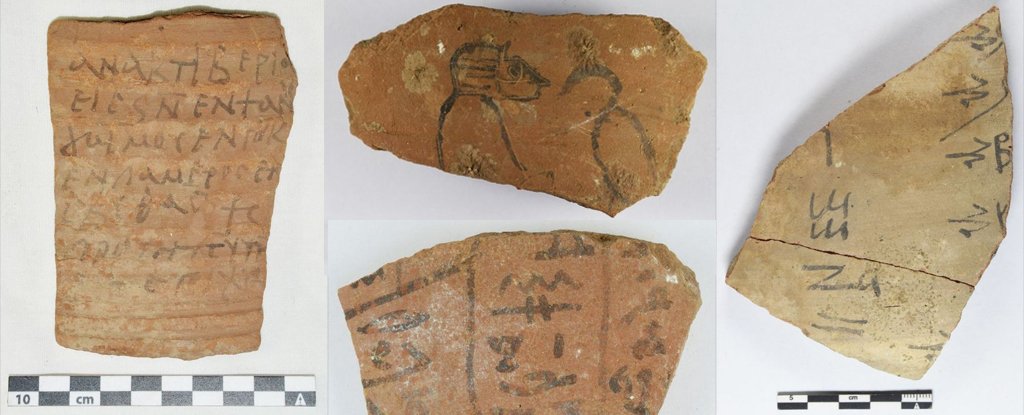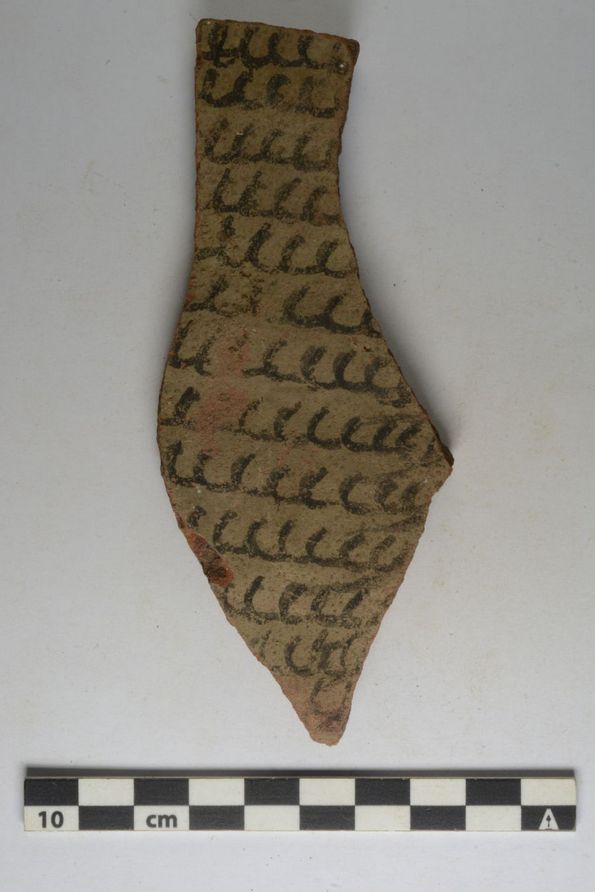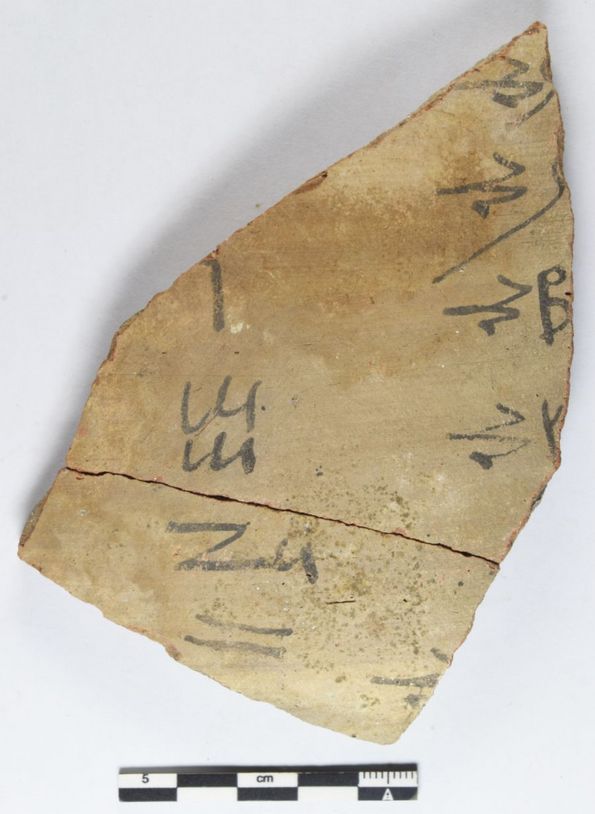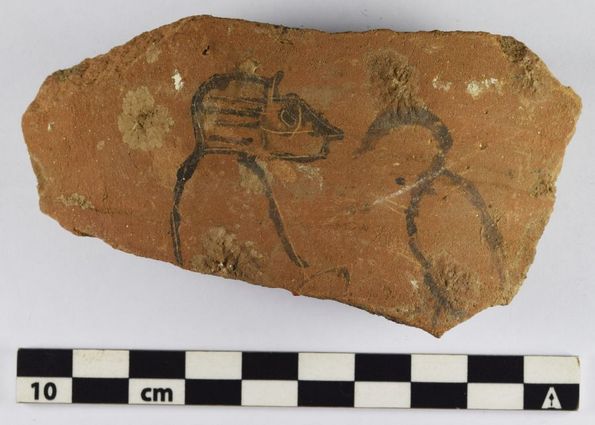
Posted on 02/07/2022 12:05:04 PM PST by Red Badger

Archaeologists have uncovered the largest collection of ancient Egyptian 'notepads' found since the beginning of the 20th century.
In the long-lost city of Athribis, in central Egypt, researchers have cataloged more than 18,000 inscribed pieces of pottery, some of which seem to have been written by students.
The shards of inked pottery are known as 'ostraca'. Much cheaper and more accessible than papyrus, remnants of broken jars and other vessels were used in ancient Egypt on a daily basis to detail shopping lists, record trades, copy literature and teach students how to write and draw.
In fact, a large number of the ostraca found at the Athribis archaeological site appear to be remnants of an ancient school.
"There are lists of months, numbers, arithmetic problems, grammar exercises and a 'bird alphabet' – each letter was assigned a bird whose name began with that letter," says Egyptologist Christian Leitz from the University of Tübingen in Germany.

A sacred text in hieroglyphics probably copied by a student. (Athribis-Project Tübingen)
More than a hundred of the ostraca found at Athribis are covered in repetitive writing exercises, with the same characters written over and over and over again, on the front and the back.
Even as far back as two thousand years ago, it seems 'naughty' children were being disciplined with the classic Bart Simpson punishment.

Line writing from ancient Egypt. (Athribis-Project Tübingen)
Most of the notes uncovered are written in Demotic, which was an administrative script used during the reign of Ptolemy XII (better known today as the father of Cleopatra), who ruled from 81 to 59 BCE and again later from 55 to 51 BCE.
During this time, the city of Athribis was the capital of an Egyptian state, located along the Nile River. But even though Demotic was clearly the more popular script of this time, a simplified form of hieroglyphics was still being taught to children.
The fragment below, for instance, is a school text of the Hieratic alphabet, with each letter accompanied by a corresponding bird.

A school text with a bird alphabet in Hieratic. (Athribis-Project Tübingen)
The various languages seen on the ostraca at Athribis, including hieroglyphics, Greek, Arabic and Coptic, hint at the city's tumultuous and multicultural history. The Coptic alphabet, for instance, is a mix of Greek and Egyptian languages and is closely associated with Christianity.
The script below is a Coptic receipt, probably written in the 6th century after Egypt had fallen into Roman hands.

(Athribis-Project Tübingen)
With the rise of Christian religion, scripts about ancient Egyptian gods began to fall out of favor. Below, for instance, is an illustration of a baboon and an ibis, which are sacred animals of Thoth, the ancient Egyptian god of wisdom.

The sacred animals of the ancient Egyptian god of wisdom, Thoth. (Athribis-Project Tübingen)
Others signs of Roman influence can also be gleaned from the shards of pottery. After the Ptolemaic system fell in the first century CE, for example, the texts begin to reference a string of Roman emperors, including Nero, Vespasian, Titus, Domitian and even Hadrian, who ruled between 117 to 138 CE.
Only once before has such a large collection of ostraca been found. In the early 1900s, archaeologists uncovered numerous shards of writing at the ancient village of Deir el-Medina, slightly further down the Nile River.
These ancient texts, however, were mostly notes about medicine and medical practices. The ostraca of Athribis, on the other hand, can tell us more about what daily life was like in one of the most powerful civilizations of the ancient world.
Sounds like what is often referred to as a 'A-B-C-D-ery', a school where writing and penmanship were taught and practiced. Such documents are found at Qumran, home to the Dead Sea Scrolls, and other scholarly centers in the ancient world.
Yup.
bread eggs beer ...
Sand and counterweights............
Good guess, but to load them on and off the boats too? Assuming they used boats, but the rock quarry was several miles down river.
You can get some of these on ebay.
Using a lever and fulcrum setup with sand and rocks as counterweights, moving the stones on/off the barges would not have been extremely difficult. Not much different than using a crane today...............
Sounds plausible but these are just modern day scientific guesses and there’s no actual record of any of that, correct? Thanks for your insights.
I’ve always wondered about that, no record.
One would think the ENGINEER(S) would have wanted to leave a record of their accomplishments, other than the objects themselves. Like a series of paintings on their tomb walls or some record of how they built the mighty pyramids. Just to show the ‘gods’ how they did the work, which must have taken a lifetime. Perhaps one day we will find such a tomb..........................
Yes, it is bizarre, that there were no pictures of the actual work being done, to commemorate the accomplishment. That’s why I made my original comment in this thread somewhat as a joke lol. My guess, perhaps planted in my mind long ago by someone else, is that it’s because they didn’t want anything showing pictures of slaves, for any reason. Either they thought it dignified them, or granted them power, etc. Thanks again.
The latest theory is that most of the workers were not slaves, but conscripts. Young men between the ages of 15 and 40 were required to serve the Pharaoh for 3 years in his building projects. They were fed well and housed nearby. Beer was available at the end of the long workday.
The artisans and ‘professionals’ were paid a stipend for their services..............
Oh great, now you’ve gone and made it even MORE of a mystery! Thanks a lot. No really, thanks a lot for all the great info. As a reward, he’s a recommend book I’ve come across, that explores many of the world’s great mysteries in detail, originally put out by Reader’s Digest. You can find it on eBay or other online stores in great condition for almost nothing, if you’re interested.
“One would think the ENGINEER(S) would have wanted to leave a record”
They did. It was in the Cloud.
The Clouds broke, the bit rain fell and much was lost.
As it was, it will soon be again
The tik tok of it’s day.
Notes to find more rocks for those dang pyramids.
Betting slips for the chariot races.
Ahmet loves Tanakate.....pass it on............
Disclaimer: Opinions posted on Free Republic are those of the individual posters and do not necessarily represent the opinion of Free Republic or its management. All materials posted herein are protected by copyright law and the exemption for fair use of copyrighted works.